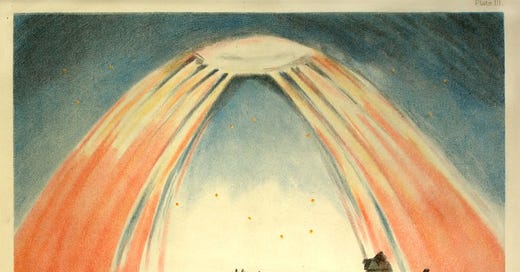Cosmic Currents: Electric Comets and the Carrington Event
A Reevaluation of the 1859 Geomagnetic Storm through the Lens of Electric Universe and Plasma Cosmology Theories, Exploring the Role of Cometary Interactions, Solar Activity, and Ancient Records of Cy
The Poetic Science of the Aurora Borealis (Image Credit: “Aurorae: Their Characters and Spectra” by John Rand Capron, 1879.)
The Carrington Event and Its Mysteries
The Carrington Event of 1859, often hailed as the most significant geomagnetic storm on record, disrupted telegraph systems globally and illuminated the night sky with vivid auroras seen as far as the tropics. Traditionally attributed to a massive coronal mass ejection (CME) impacting Earth's magnetosphere, recent analyses, such as Boris R. German's study, suggest a more complex interplay of forces. German’s hypothesis posits that fragments of Comet 3D/Biela may have contributed to the storm's anomalies, including unusual auroral colors, magnetic field oscillations, and a lack of corroborating evidence for the expected solar energetic particle (SEP) fallout.
Electric Comets and Plasma Interactions
In the framework of the Electric Universe and Plasma Cosmology theories, comets are not icy wanderers but electrically active bodies. As comets traverse the Sun’s electric field, their interactions with the solar wind produce glowing tails and plasma sheaths. The fragmented Comet 3D/Biela, approaching Earth’s orbit during the Carrington Event, could have introduced additional charged material into Earth’s magnetosphere. This interaction might have amplified geomagnetic disturbances, explaining the six-hour periodicity in magnetic oscillations observed at the time.
Additionally, comets carry unique electrical signatures influenced by their charge state and proximity to the Sun. The potential for such fragments to modulate Earth’s electromagnetic environment underscores the plausibility of German’s hypothesis. The auroral hues and unprecedented geomagnetic disruptions align with a scenario where both solar and cometary electrical inputs combined to produce the observed phenomena.
Earth’s Weakening Magnetosphere and Solar Cycles
Earth’s magnetosphere, currently in a phase of weakening, exacerbates its vulnerability to both solar and interstellar electromagnetic forces. Periods of grand solar minima—characterized by reduced solar magnetic activity—coincide with heightened cosmic ray influx and increased interactions with passing cometary debris. In the context of cyclical solar catastrophism, recorded by ancient civilizations in myths, legends, and petroglyphs, comets often symbolize agents of destruction and renewal. These records suggest a collective memory of heliospheric and geomagnetic shifts triggering terrestrial upheavals.
The plasma discharges associated with comets in proximity to Earth, combined with geomagnetic weakening, could replicate the conditions that German identifies as central to the Carrington Event. The broader implications link these phenomena to a cyclical interplay of solar activity, geomagnetic dynamics, and the influx of cosmic material.
Myths, Legends, and Electrical Phenomena
Ancient petroglyphs and texts frequently depict plasma-like shapes resembling the forms seen in laboratory plasma discharge experiments. These visual records may encode humanity’s observations of past celestial events involving electric comets and solar storms. The consistent association of comets with omens and catastrophes underscores their role as visible markers of significant electromagnetic disruptions.
Conclusion
German’s reinterpretation of the Carrington Event invites a paradigm shift in understanding geomagnetic storms. By integrating the Electric Universe and Plasma Cosmology perspectives, the interplay between solar activity, cometary fragments, and Earth’s electromagnetic environment emerges as a holistic framework for interpreting past and future celestial phenomena.
References
German, Boris R. "The Carrington Event Paradoxes and 3D/Biela Comet." ResearchGate, Link.
Thornhill, Wallace, and David Talbott. The Electric Universe. Mikamar Publishing, 2007. Link.
Peratt, Anthony L. "Characteristics for the Occurrence of a High-Current, Z-Pinch Aurora as Recorded in Antiquity." IEEE Transactions on Plasma Science, 2003. Link.
NASA. "The Carrington Event." Link.
McCanney, James M. "The Plasma Discharge Comet Model." James McCanney Science, 2002. Link.





